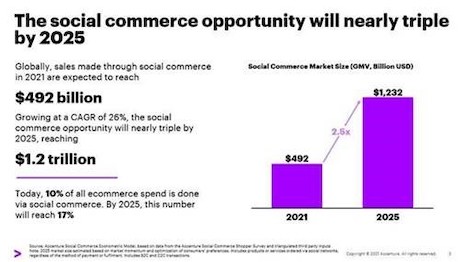 Brands and retailers have ample opportunities to score sales through social commerce. Image credit: Burberry
Brands and retailers have ample opportunities to score sales through social commerce. Image credit: Burberry
Social commerce is growing rapidly, driven by Gen Z and millennial shoppers, according to new research from Accenture.
The new study finds that the $492 billion social commerce industry is expected to grow to $1.2 trillion by 2025. With such dramatic growth, especially during the time of continued COVID-19 restrictions, retailers and brands have ample opportunity to position themselves in front of shoppers to ensure increased revenue.
“The pandemic showed how much people use social platforms as the entry point for everything they do online — news, entertainment and communication,” said Robin Murdoch, global software & platforms industry lead at Accenture, in a statement.
“The steady rise in time spent on social media reflects how essential these platforms are in our daily life,” he said. “They are reshaping how people buy and sell, which provides platforms and brands with new opportunities for user experiences and revenue streams.”
The findings are based on an Accenture survey of more than 10,053 social media users in China, India, the United States, Brazil and the United Kingdom conducted between Aug. 12 and Sept. 3, 2021. Accenture also conducted interviews with shoppers and sellers from those same five markets between May 26 and June 2, 2021.
Shopping becomes a social affair
Accenture defines social commerce as a user’s entire shopping experience, from product discovery to the checkout process, taking place on a social media platform.
Almost two-thirds of social media users, 64 percent, said they made a social commerce purchase in the last year, which is estimated to reflect almost 2 billion social buyers globally.
 Ten percent of all ecommerce is done through social commerce. Image credit: Accenture
Ten percent of all ecommerce is done through social commerce. Image credit: Accenture
Millennials are expected to account for one-third of social commerce spending by 2025; however, Gen Z spending is expected to grow the fastest.
Social commerce effectively reaches buyers in disparate ways.
Brands effectively employ social commerce spaces through curating meaningful and attention-grabbing content to invite consumers to join experiences like livestreaming and AR/VR events and tapping existing networks and influencers to spread the word about offerings.
In regards to what is selling, by 2025 Accenture anticipates the highest number of social commerce purchases globally will be for clothing at 18 percent, followed by consumer electronics at 13 percent and home décor at 7 percent.
Businesses of any size have ample opportunity on social platforms.
Nearly six in 10 social buyers said they are more likely to support small and medium-sized businesses through social commerce than when shopping on ecommerce websites. Sixty-three percent said they are more likely to buy from the same seller again, reflecting how social commerce can effectively foster brand loyalty and repeat purchasing.
 Social platforms such as TikTok continue tapping into social commerce opportunities. Image credit: Unsplash
Social platforms such as TikTok continue tapping into social commerce opportunities. Image credit: Unsplash
Overall, China continues to lead the pack in consumers flocking to social commerce. Eight in 10 social media users in China make purchases for a given category, while the majority of social media users in the U.K. and the U.S. have not yet made a purchase via social commerce.
Shoppers in China, India and Brazil note caring more about features that help them discover potential purchases while shoppers in the U.K. and U.S. prioritize pricing and discounts.
Social commerce expansion
Brands and retailers are continuously recognizing the benefits of social commerce while fostering their ability to spotlight their offerings on social platforms.
Several social platforms are paving the way for organizations to expand their social commerce offerings.
In September 2021, TikTok added more marketing solutions, with an emphasis on strengthening brand and creator collaboration.
The new tools include the self-service TikTok Creator Marketplace, brand landing pages, enhanced campaigns metrics and the TikTok Shopping suite. TikTok Shopping allows merchants to manage a full ecommerce experience, from uploading products to handling shipping, point-of-sale, shipping and fulfillment.
Live Shopping is also allowing brands to engage with users in real-time through livestreaming (see story).
Social media has transformed into the ultimate shopping destination, and brands are taking note.
During the Financial Times “Future of Retail” virtual conference on Sept. 23, industry experts discussed how the COVID-19 pandemic and the innate tech-savviness of younger generations have shaped new ecommerce capabilities among social platforms. As consumers continue to turn to social commerce, brands cannot neglect the opportunity to augment their social presences and capitalize on these apparently permanent digital buying habits (see story).
Social commerce is still a budding arena, leaving brands and retailers the space to experiment with what works for them in terms of reaching shoppers.
“Social commerce is a leveling force that is driven by the creativity, ingenuity and power of people,” said Oliver Wright, global consumer goods and services lead at Accenture, in a statement. “It empowers smaller brands and individuals and makes big brands reevaluate their relevance for a marketplace of millions of individuals.
“Getting social commerce right will require creators, resellers and brands to bring their products and services where the consumer is, and will be, rather than the other way around,” he said. “It means working together within a dynamic ecosystem of platforms, marketplaces, social media and influencers to share data, insights and capabilities to deliver the right incentives and best consumer experience across an integrated digital marketplace.”